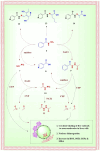Isoniazid-historical development, metabolism associated toxicity and a perspective on its pharmacological improvement
- PMID: 39364056
- PMCID: PMC11447295
- DOI: 10.3389/fphar.2024.1441147
Isoniazid-historical development, metabolism associated toxicity and a perspective on its pharmacological improvement
Abstract
Despite the extraordinary anti-tubercular activity of isoniazid (INH), the drug-induced hepatotoxicity and peripheral neuropathy pose a significant challenge to its wider clinical use. The primary cause of INH-induced hepatotoxicity is in vivo metabolism involving biotransformation on its terminal -NH2 group owing to its high nucleophilic nature. The human N-acetyltransferase-2 enzyme (NAT-2) exploits the reactivity of INH's terminal -NH2 functional group and inactivates it by transferring the acetyl group, which subsequently converts to toxic metabolites. This -NH2 group also tends to react with vital endogenous molecules such as pyridoxine, leading to their deficiency, a major cause of peripheral neuropathy. The elevation of liver functional markers is observed in 10%-20% of subjects on INH treatment. INH-induced risk of fatal hepatitis is about 0.05%-1%. The incidence of peripheral neuropathy is 2%-6.5%. In this review, we discuss the genesis and historical development of INH, and different reported mechanisms of action of INH. This is followed by a brief review of various clinical trials in chronological order, highlighting treatment-associated adverse events and their occurrence rates, including details such as geographical location, number of subjects, dosing concentration, and regimen used in these clinical studies. Further, we elaborated on various known metabolic transformations highlighting the involvement of the terminal -NH2 group of INH and corresponding host enzymes, the structure of different metabolites/conjugates, and their association with hepatotoxicity or neuritis. Post this deliberation, we propose a hydrolysable chemical derivatives-based approach as a way forward to restrict this metabolism.
Keywords: N-acetyltransferase; hepatotoxicity; isoniazid; metabolism; peripheral neuropathy; prodrug.
Copyright © 2024 Sankar, Chauhan, Singh and Mahajan.
Conflict of interest statement
The authors declare that the research was conducted in the absence of any commercial or financial relationships that could be construed as a potential conflict of interest.
Figures








Similar articles
-
Isoniazid: metabolic aspects and toxicological correlates.Curr Drug Metab. 2007 Dec;8(8):839-51. doi: 10.2174/138920007782798216. Curr Drug Metab. 2007. PMID: 18220565 Review.
-
Effect of NAT2, GSTM1 and CYP2E1 genetic polymorphisms on plasma concentration of isoniazid and its metabolites in patients with tuberculosis, and the assessment of exposure-response relationships.Front Pharmacol. 2024 Mar 22;15:1332752. doi: 10.3389/fphar.2024.1332752. eCollection 2024. Front Pharmacol. 2024. PMID: 38584604 Free PMC article.
-
Association of isoniazid-metabolizing enzyme genotypes and isoniazid-induced hepatotoxicity in tuberculosis patients.In Vivo. 2011 Sep-Oct;25(5):803-12. In Vivo. 2011. PMID: 21753138
-
Deficiency of N-acetyltransferase increases the interactions of isoniazid with endobiotics in mouse liver.Biochem Pharmacol. 2017 Dec 1;145:218-225. doi: 10.1016/j.bcp.2017.09.001. Epub 2017 Sep 6. Biochem Pharmacol. 2017. PMID: 28888949 Free PMC article.
-
Pharmacokinetics of isoniazid: The good, the bad, and the alternatives.Tuberculosis (Edinb). 2019 May;116S:S66-S70. doi: 10.1016/j.tube.2019.04.012. Epub 2019 Apr 26. Tuberculosis (Edinb). 2019. PMID: 31076322 Review.
Cited by
-
How could emerging nanomedicine-based tuberculosis treatments outperform conventional approaches?Nanomedicine (Lond). 2025 Apr;20(7):645-647. doi: 10.1080/17435889.2025.2458447. Epub 2025 Jan 29. Nanomedicine (Lond). 2025. PMID: 39877965 No abstract available.
-
Nutritional Deficiencies and Management in Tuberculosis: Pharmacotherapeutic and Clinical Implications.Nutrients. 2025 May 30;17(11):1878. doi: 10.3390/nu17111878. Nutrients. 2025. PMID: 40507146 Free PMC article. Review.
-
The role of isoniazid dosage and NAT2 gene polymorphism in the treatment of tuberculous meningitis.Front Immunol. 2025 Jan 20;15:1535447. doi: 10.3389/fimmu.2024.1535447. eCollection 2024. Front Immunol. 2025. PMID: 39902038 Free PMC article.
-
Exploring the Antimycobacterial Potential of Podocarpusflavone A from Kielmeyera membranacea: In Vitro and In Vivo Insights.Pharmaceuticals (Basel). 2024 Nov 21;17(12):1560. doi: 10.3390/ph17121560. Pharmaceuticals (Basel). 2024. PMID: 39770402 Free PMC article.
References
-
- Agarwal A., Bansal R., Sharma S., Meena M., Airun M. (2016). Near fatal poisoning by isoniazid and rifampicin-a case report and review of literature. Indian J. Forensic Med. Toxicol. 10 (1), 147–150. 10.5958/0973-9130.2016.00034.7 - DOI
Publication types
LinkOut - more resources
Full Text Sources

